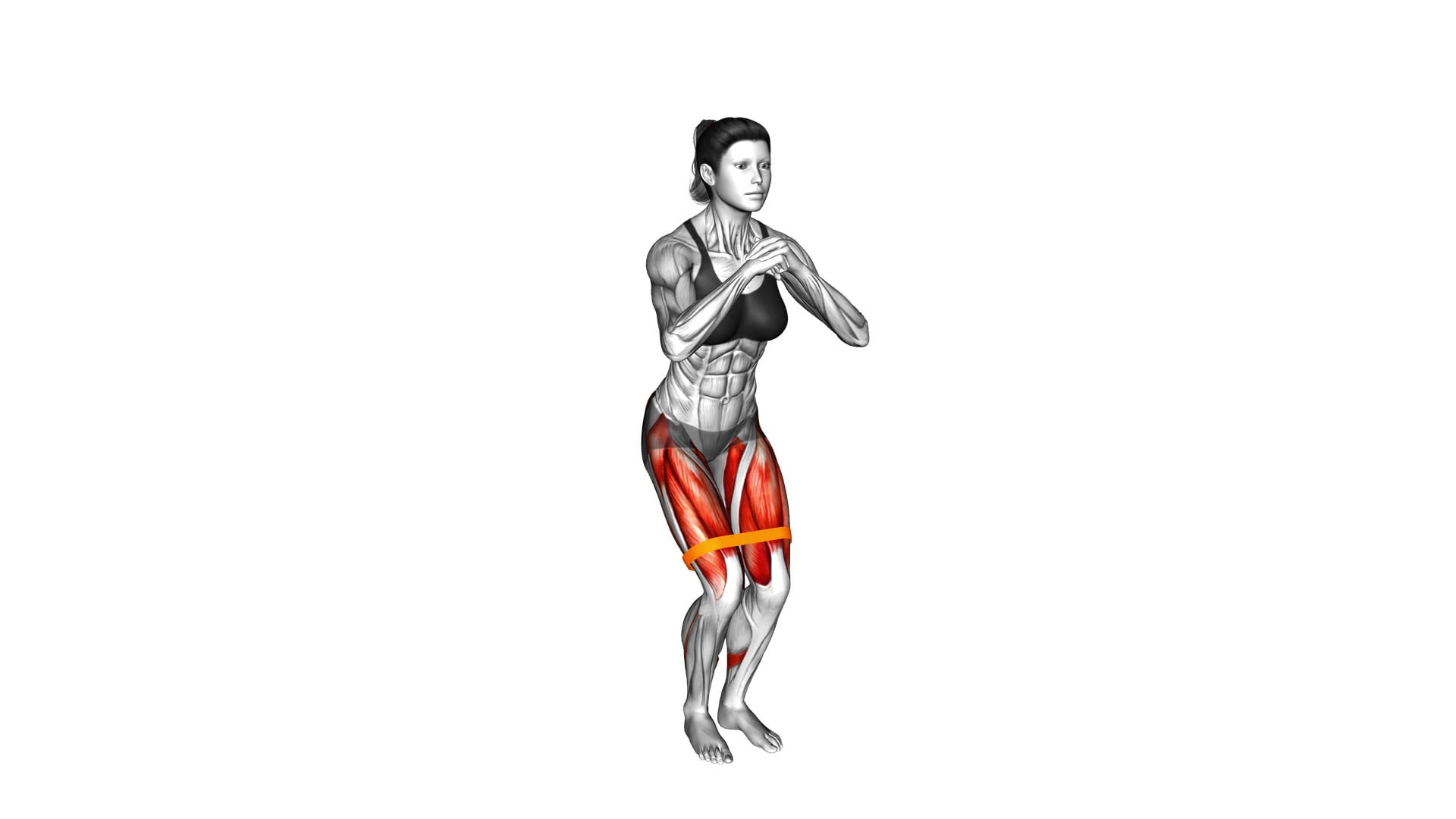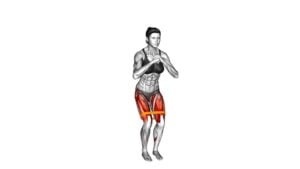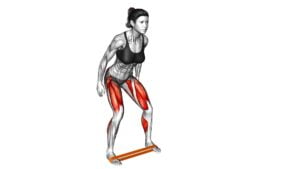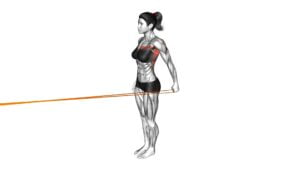Resistance Band Lateral Step and Squat (female) – Video Exercise Guide & Tips

Are you looking to tone your lower body and build strength? Look no further than the resistance band lateral step and squat!
Watch This Exercise Video
This exercise targets your glutes, quads, and hips, helping you achieve those lean, sculpted legs.
In this video exercise guide, we'll show you the proper form and technique, variations to increase difficulty, and common mistakes to avoid.
Get ready to feel the burn and see amazing results with this effective workout.
Let's get started!
Key Takeaways
- Resistance band lateral step and squat targets glutes, quads, and hips.
- Proper form and technique include standing with feet hip-width apart and keeping the back straight and core engaged.
- Increasing the difficulty can be achieved by adding weight, performing on an unstable surface, slowing down tempo, increasing resistance band tension, and incorporating single-leg variations.
- Core engagement is important as it improves balance, posture, overall strength, stability during exercise, reduces the risk of injuries, and maximizes the benefits of the resistance band lateral step and squat.
Benefits of Resistance Band Lateral Step and Squat
To maximize your workout, incorporating the resistance band lateral step and squat can provide numerous benefits for your lower body strength and stability. Proper breathing and muscle activation are key components of this exercise that contribute to its effectiveness.
When performing the resistance band lateral step and squat, it's important to maintain proper breathing techniques. Inhale deeply before starting the movement and exhale as you push through the step and squat. This controlled breathing helps to oxygenate your muscles, allowing for better endurance and performance.
Additionally, the resistance band lateral step and squat activates several major muscle groups in your lower body. The lateral step engages your glutes, hips, and thighs, while the squat targets your quadriceps, hamstrings, and calves. By incorporating this exercise into your routine, you can strengthen and tone these muscles, improving overall lower body strength.
Furthermore, the resistance band adds an extra level of resistance, increasing the intensity of the exercise. This challenge not only builds muscular strength but also enhances stability and balance.
In conclusion, the resistance band lateral step and squat is a highly effective exercise for improving lower body strength and stability. By incorporating proper breathing and focusing on muscle activation, you can maximize the benefits of this exercise.
Next, let's delve into the importance of proper form and technique to ensure you get the most out of this exercise.
Proper Form and Technique
Ensure you maintain proper form and technique while performing the resistance band lateral step and squat exercise. Proper form is essential to maximize muscle activation and avoid injury. To begin, stand with your feet hip-width apart and place a resistance band around your ankles. Keep your back straight, core engaged, and shoulders relaxed throughout the exercise.
To perform the lateral step, take a wide step to the side with your right foot, ensuring that your knees are aligned with your toes. Keep tension on the resistance band by maintaining a slight bend in your knees. Push off with your right foot and return to the starting position. Repeat the same movement with your left foot.
For the squat, start with your feet hip-width apart. Lower your body by bending your knees and pushing your hips back. Keep your chest up and your weight in your heels. Lower until your thighs are parallel to the ground, then push through your heels to return to the starting position.
Remember to maintain control throughout the exercise and avoid any jerky or sudden movements. By focusing on proper form and technique, you'll engage the correct muscles and reduce the risk of injury.
Variations to Increase Difficulty
To increase the difficulty of the resistance band lateral step and squat exercise, you can incorporate variations that challenge your muscles in new ways. One advanced modification you can try is to add weight to the exercise. This can be done by holding dumbbells or wearing a weighted vest while performing the lateral step and squat. The additional weight will increase the resistance and force your muscles to work harder, leading to greater strength and muscle growth.
Another way to increase the difficulty is by performing the exercise on an unstable surface. This can be achieved by using a balance board, Bosu ball, or foam pad. The unstable surface will challenge your core stability and require even more muscle activation to maintain proper form throughout the exercise.
Additionally, you can try performing the lateral step and squat at a slower tempo. This will increase the time under tension for your muscles, making the exercise more challenging and effective for building strength and endurance.
By incorporating these advanced modifications into your resistance band lateral step and squat routine, you can continue to challenge your muscles and make progress towards your fitness goals.
Now let's move on to the next section and discuss common mistakes to avoid when performing this exercise.
Common Mistakes to Avoid
When performing the resistance band lateral step and squat, it's important to pay attention to your form.
Make sure to keep your knees in line with your toes to avoid knee collapse and potential injury.
Additionally, don't forget to engage your core throughout the exercise to maintain stability and maximize the benefits of the workout.
Proper Form Tips
Avoid leaning forward excessively during the resistance band lateral step and squat exercise to maintain proper form and prevent injury. One common misconception is that leaning forward will make the exercise more effective, but in reality, it can put strain on your lower back and compromise your form. Instead, focus on keeping your back straight and your chest up throughout the movement.
Another mistake to avoid isn't using a resistance band that's appropriate for your fitness level. Beginners can modify the exercise by using a lighter resistance band or even starting without a band at all. As you become more comfortable and stronger, you can gradually increase the resistance.
Avoiding Knee Collapse
Use a proper resistance band to prevent knee collapse during the lateral step and squat exercise. This is crucial for preventing injury and strengthening your hip muscles.
When performing the exercise, make sure the resistance band is securely attached to your ankles and provides enough tension. As you step laterally or squat, keep your knees aligned with your toes and avoid letting them collapse inward. Knee collapse can put excessive stress on your knees, leading to potential injury.
By maintaining proper form and engaging your hip muscles, you can prevent knee collapse and ensure a safe and effective workout. Strengthening your hip muscles is important as they play a key role in stabilizing your knees and protecting them from injury.
Core Engagement Importance
To maximize the effectiveness of the resistance band lateral step and squat exercise, it's essential to prioritize core engagement. Engaging your core muscles during this exercise not only helps to stabilize your body, but it also enhances the overall benefits of the workout.
Core engagement is crucial in fitness training because it improves your balance, posture, and overall strength. When your core is strong and stable, you're less likely to experience injuries and can perform exercises with proper form and technique.
To improve your core strength and stability, focus on exercises that specifically target these muscles, such as planks, Russian twists, and mountain climbers. By incorporating these techniques into your routine, you can optimize your core engagement and take your fitness training to the next level.
Tips for Maximum Results
For maximum results, focus on maintaining proper form and engaging your glutes and quads throughout the exercise. To maximize gains and get the most out of your resistance band lateral step and squat, it's essential to pay attention to your form and target the right muscle groups.
First and foremost, ensure that you have a good stance with your feet shoulder-width apart. This will provide a stable base for the exercise and allow you to maintain balance and control. As you step laterally with the resistance band around your ankles, make sure to keep tension in the band throughout the movement. Engage your glutes by pushing your hips back and down into a squat position. This will activate your quads as well, ensuring that both muscle groups are working together to provide maximum results.
Another tip is to focus on your breathing. Inhale as you step laterally and prepare for the squat, then exhale as you push through your heels and return to the starting position. This will help you maintain control and stability throughout the exercise.
Lastly, remember to start with a lighter resistance band and gradually increase the intensity as you get stronger. This will allow you to progress and continue challenging your muscles, leading to more effective training techniques and better results in the long run.
Sample Resistance Band Lateral Step and Squat Workout
To get the most out of your resistance band lateral step and squat workout, incorporate a variety of exercises that target your glutes and quads. Resistance band exercises are a great way to add intensity and resistance to your lower body workout. They provide continuous tension on your muscles, helping you to build strength and tone.
Start your workout with some warm-up exercises, such as glute bridges and bodyweight squats, to activate your muscles and prepare them for the workout ahead. Then, move on to the resistance band lateral step and squat. This exercise targets your glutes, quads, and outer thighs.
To perform it, place the resistance band around your thighs, just above your knees. Take a wide step to the side, keeping tension on the band, and then lower into a squat position. Push through your heels to return to the starting position and repeat on the other side.
To add variation to your workout, try incorporating other resistance band exercises such as standing kickbacks, fire hydrants, and clamshells. These exercises will further engage your glutes and quads, helping you to sculpt and strengthen your lower body.
Remember to maintain proper form throughout each exercise and to listen to your body. If something doesn't feel right, adjust or modify the exercise as needed. With consistency and dedication, you'll see progress and results in no time.
Keep pushing yourself and enjoy the benefits of your resistance band lateral step and squat workout.
Frequently Asked Questions
How Long Does It Take to See Results From Resistance Band Lateral Step and Squat Exercises?
Resistance band lateral step and squat exercises can produce results in a relatively short amount of time. By consistently performing these exercises correctly, you can start seeing improvements in your strength, stability, and overall lower body muscle tone.
Incorporating resistance band lateral step and squat exercises into your workout routine offers several benefits, such as targeting multiple muscle groups, increasing calorie burn, and improving balance.
Stay committed and you'll soon notice the positive effects of these exercises on your fitness journey.
Can Resistance Band Lateral Step and Squat Exercises Help With Weight Loss?
Resistance band exercises, such as the lateral step and squat, can be beneficial for weight loss. By incorporating resistance bands into your workout routine, you can increase the intensity of your squats and engage more muscles in your legs and glutes. This can lead to more calories burned and increased muscle tone.
Resistance bands also provide a portable and versatile option for exercising, making it easier to stay consistent with your fitness goals.
Are Resistance Band Lateral Step and Squat Exercises Suitable for Beginners?
Resistance band lateral step and squat exercises can be suitable for beginners. If you're just starting out, it's important to listen to your body and go at your own pace. If the resistance band is too challenging, you can modify the exercise by using a lighter band or no band at all.
Alternatively, there are beginner-friendly exercises that can help you build strength and stability before attempting the lateral step and squat with a resistance band.
Can Resistance Band Lateral Step and Squat Exercises Help Improve Balance and Stability?
Resistance band lateral step and squat exercises can definitely help improve your balance and stability. By incorporating these exercises into your workout routine, you'll be able to enhance your coordination while increasing your lower body strength.
These exercises target key muscles in your hips, thighs, and glutes, which are essential for maintaining stability and balance. So, if you're looking to enhance these aspects of your fitness, resistance band lateral step and squat exercises are a great choice.
Are There Any Specific Precautions or Contraindications to Be Aware of When Performing Resistance Band Lateral Step and Squat Exercises?
When performing resistance band lateral step and squat exercises, there are a few precautions and contraindications to be aware of.
- It's important to use proper form and technique to avoid injury.
- Start with a lighter resistance band and gradually increase as you become more comfortable.
- If you have any pre-existing knee or hip injuries, it's best to consult with a healthcare professional before attempting these exercises.
- Always listen to your body and stop if you experience any pain or discomfort.
Stay safe and enjoy your workout!
Conclusion
Incorporating resistance band lateral step and squats into your workout routine can offer numerous benefits, including improved lower body strength and stability.
By maintaining proper form and technique, you can effectively target your glutes, quads, and hamstrings.
Adding variations to increase difficulty can further challenge your muscles and help you progress in your fitness journey.
Remember to avoid common mistakes and follow the tips provided for maximum results.
Try incorporating this exercise into your next workout for a well-rounded lower body workout.

Author
Years ago, the spark of my life’s passion ignited in my mind the moment I stepped into the local gym for the first time. The inaugural bead of perspiration, the initial endeavor, the very first surge of endorphins, and a sense of pride that washed over me post-workout marked the beginning of my deep-seated interest in strength sports, fitness, and sports nutrition. This very curiosity blossomed rapidly into a profound fascination, propelling me to earn a Master’s degree in Physical Education from the Academy of Physical Education in Krakow, followed by a Sports Manager diploma from the Jagiellonian University. My journey of growth led me to gain more specialized qualifications, such as being a certified personal trainer with a focus on sports dietetics, a lifeguard, and an instructor for wellness and corrective gymnastics. Theoretical knowledge paired seamlessly with practical experience, reinforcing my belief that the transformation of individuals under my guidance was also a reflection of my personal growth. This belief holds true even today. Each day, I strive to push the boundaries and explore new realms. These realms gently elevate me to greater heights. The unique combination of passion for my field and the continuous quest for growth fuels my drive to break new ground.



